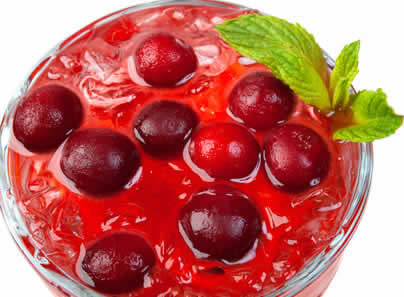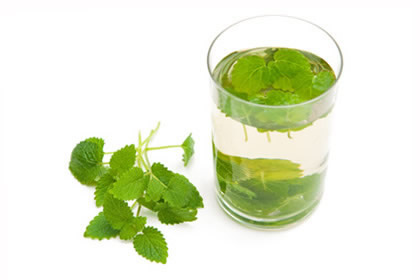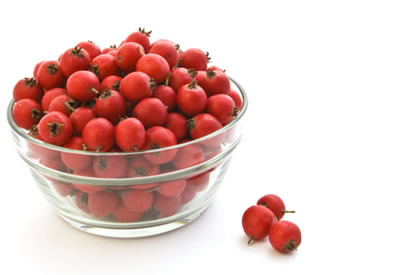Cranberry (Vaccinium macrocarpon) is an evergreen shrub related to buckberry, blueberry, bilberry, and huckleberry. The reddish-black fruit appear in the months of June and July. Fruit contain compounds called proanthocyanidins, which give them their red color.
Cranberry Juice Benefits and Diseases
Cranberry are rich in antioxidants. The important type of polyphenolic compound found in cranberry is proanthocyanidins. Antioxidants are substances that protect cells from oxidative damage caused by molecules called free radicals. Free radicals are unstable molecules that attack normal cells and damage membranes. Cell death caused by free radicals contributes to a variety of diseases, including heart disease, some forms of cancer and nervous system disorders such as Alzheimer’s. Elevated antioxidant amounts in the body may protect against damage to cells and cellular components, thus helping to reduce the risk of many chronic degenerative diseases.
Various polyphenolic compounds such as flavonoids have been identified as having powerful antioxidant activities. Cranberry are one of the most rich sources of flavonoids that have a potent antioxidant and anti-inflammatory effects. Therefore, consumption of cranberries could be of importance not only in the maintenance of health but also in preventing cardiovascular disease. Cranberry score high on the antioxidant scale at 1750 ORAC units per 100 g of fresh fruit. Cranberry have been shown to contain more antioxidant phenols than 19 commonly eaten fruits according to a research reported in the Nov, 2001 issue of the Journal of Agriculture and Food Chemistry.
Urinary Tract Infections (UTIs)
Cranberries has a long history of use primarily for treating urinary problems. New researches have shown it can reduce the ability of Escherichia coli to adhere to the lining of the bladder and urethra, reducing the potential for urinary tract infections. Some lab experiments showed that cranberry also prevent other microorganism known as Helicobacter pylori from adhering to cell walls.
Previously, scientists believed that the effect of cranberry juice to help prevent urinary tract infections was partly related to the potent acidity of the cranberry. However scientists don’t believe this explanation any more. No longer, researches show that cranberry juice may prevent bacteria from attaching to the walls of the urinary tract. Cranberry juice contain proanthocyanidins, which inhibit the fimbrial adhesion of bacteria, including E. coli, to the urinary tract epithelium and hence the subsequent reproduction required for infection. The proanthocyanidins in cranberry inhibit the adherence of Escherichia coli fimbriae to uroepithelial cells in vitro. Adhesion of Escherichia coli bacteria to cells lining the urinary tract is the first step in the development of a urinary tract infections, and Escherichia coli is the cause of approximately 85 % of urinary tract infections.
Research shows that drinking cranberry juice can help prevent repeated urinary tract infections in older women. In one study of older women, cranberry juice decreased the amount of bacteria in the bladder compared to placebo. Other a study demonstrated that younger women with a history of frequent urinary tract infections (UTIs) who took cranberry capsules had fewer UTIs compared to those who took placebo. A study reported in the Phytomedicine concluded that cranberry extract proved effective in preventing recurrent UTIs.
Benign Prostatic Hyperplasia and Chronic Prostatitis
 Cranberry extract appears to be a effective therapy to manage symptoms of Benign prostatic hyperplasia (BPH) and chronic prostatitis. A 2011 study performed at the “Catholic University of Korea College of Medicine “, demonstrated that cranberry extract reduced bacterial growth in the prostate tissue of animals with chronic bacterial prostatitis. During the 6-month a study, participants were given 1,500 mg of cranberry fruit powder per day. Compared with the control group, patients symptoms in the cranberry group significantly healed in a few areas by the end of the study, including quality of life, rate and amount of urinary frequency, urine flow, urgency, and waking at night to urinate. In a study “Cancer Management and Research” reported that cranberry extract was effective in reducing the risk of urinary tract infections and lower urinary tract symptoms in men who were undergoing radiation treatment for prostate cancer. Particularly, of the 184 patient given cranberry extract, just 16 experienced a urinary tract infection associated with radiation treatment, compared with 45 of 186 men in the control group.
Cranberry extract appears to be a effective therapy to manage symptoms of Benign prostatic hyperplasia (BPH) and chronic prostatitis. A 2011 study performed at the “Catholic University of Korea College of Medicine “, demonstrated that cranberry extract reduced bacterial growth in the prostate tissue of animals with chronic bacterial prostatitis. During the 6-month a study, participants were given 1,500 mg of cranberry fruit powder per day. Compared with the control group, patients symptoms in the cranberry group significantly healed in a few areas by the end of the study, including quality of life, rate and amount of urinary frequency, urine flow, urgency, and waking at night to urinate. In a study “Cancer Management and Research” reported that cranberry extract was effective in reducing the risk of urinary tract infections and lower urinary tract symptoms in men who were undergoing radiation treatment for prostate cancer. Particularly, of the 184 patient given cranberry extract, just 16 experienced a urinary tract infection associated with radiation treatment, compared with 45 of 186 men in the control group.
Peptic Ulcers
Some preliminary research findings demonstrate that cranberries may be useful in the prevention of peptic ulcers through the inhibition of Helicobacter pylori adhesion to gastric mucus and stomach epithelium. Regular consumption of cranberry juice can suppress Helicobacter pylori infection, a important factor in peptic ulcer disease and gastric cancer. In the study which was reported in the Apr 2005 edition of the journal Helicobacter, researchers proved that the usage of 250 ml of cranberry juice twice daily for 90 days suppressed H. pylori infection compared with a placebo.
Anticarcinogenic Activities
In 1996 lab experiments performed by University of Illinois researchers and reported in “Planta Medica” showed the possible anticarcinogenic activities of cranberry. In studies of cancer prevention and cure, cranberries extracts showed anti-proliferative activity against breast, prostate, colon, liver and oral cancer cell lines in vitro. In a study performed by scientists at the Department of Physiology & Pharmacology, University of Western Ontario, investigated the effect of cranberry extract on mice that had been injected with human breast tumor cells, prostate cancer cells and colon cancer cells. As a result, in all cases decrease the growth and metastasis of the cancer tumors.
Cardiovascular Disease
Cranberries may help to protect against cardiovascular disease. Cranberries contain important levels of flavonoids compounds that have been showed to inhibit low density lipoprotein oxidation. Flavonoids have been shown to function as strong antioxidants both in vitro and in vivo and may lessen the risk of atherosclerosis (hardening and narrowing of the arteries). Atherosclerosis can slowly narrow and harden the arteries throughout the body. This condition causes cardiovascular disease that lead to heart attacks and stroke.
Cranberries are especially important source of phenolic phytochemicals, including phenolic acids and flavonoids. The cranberries flavonoids belong to 3 groups; anthocyanins, flavonols, and proanthocyanidins. Polyphenols and flavonoids improve the function of platelets, irregularly shaped cells in the blood that help with clotting. Latest research findings demonstrate that polyphenols, including those found in cranberry, may contribute to reducing the risk of cardiovascular disease by increasing the resistance of LDL to oxidation, inhibiting platelet aggregation, reducing blood pressure.
Dosage
The National Kidney Foundation suggests drinking 300 ml glass of cranberry juice cocktail a day may help prevent urinary tract infections. If you prefer in capsule form, the University of Maryland Medical Center (UMM) suggests 300 to 400 mg daily in divided doses. For BPH; some researches shows that taking dried cranberry capsules, 3 times daily for 6 months, might improve urinary symptoms and lower blood levels of PSA.
 Arthritis is an inflammation of the joints. The rosmarinic acid in rosemary has powerful antioxidant and anti-inflammatory effects which help lessen inflammation of joints. There is a study reported in the Sep 2007 edition of Canadian Journal of Physiology and Pharmacology demonstrated rosemary, in combination with other plants, was effective way to lessen pain in individuals who suffer from osteoarthritis. Applied topically, rosemary oil is used to treat muscle pain and arthritis and to improve circulation. The Commission E, has approved rosemary essential oil as a topical therapy for muscle pain and arthritis.
Arthritis is an inflammation of the joints. The rosmarinic acid in rosemary has powerful antioxidant and anti-inflammatory effects which help lessen inflammation of joints. There is a study reported in the Sep 2007 edition of Canadian Journal of Physiology and Pharmacology demonstrated rosemary, in combination with other plants, was effective way to lessen pain in individuals who suffer from osteoarthritis. Applied topically, rosemary oil is used to treat muscle pain and arthritis and to improve circulation. The Commission E, has approved rosemary essential oil as a topical therapy for muscle pain and arthritis. Lemon balm used as an anxiolytic, mild sedative or calming remedy. Melissa extract was identified as a strong in vitro inhibitor of GABA transaminase, which explains anxiolytic activities. The important compound responsible for GABA transaminase inhibition activity in melissa officinalis was then found to be rosmarinic acid. Some studies show that melissa officinalis combined with other herbs (as hops and valerian) helps decrease anxiety and promote sleep. In one study of participants with mild sleep problems, 81% of those who took an herbal combination of lemon balm and valerian reported sleeping much better than those who took placebo. In a other double blind, placebo controlled study, 18 healthful participant received 2 separate single doses of a standardized melissa extract (300 mg and 600 mg) or placebo for 7 days.The 600 milligrams dose of melissa increased mood and significantly increased calmness and alertness.
Lemon balm used as an anxiolytic, mild sedative or calming remedy. Melissa extract was identified as a strong in vitro inhibitor of GABA transaminase, which explains anxiolytic activities. The important compound responsible for GABA transaminase inhibition activity in melissa officinalis was then found to be rosmarinic acid. Some studies show that melissa officinalis combined with other herbs (as hops and valerian) helps decrease anxiety and promote sleep. In one study of participants with mild sleep problems, 81% of those who took an herbal combination of lemon balm and valerian reported sleeping much better than those who took placebo. In a other double blind, placebo controlled study, 18 healthful participant received 2 separate single doses of a standardized melissa extract (300 mg and 600 mg) or placebo for 7 days.The 600 milligrams dose of melissa increased mood and significantly increased calmness and alertness. Volatile oils made from sage have anti-bacterial activities and may be helpful in mouthwash or toothpaste form. A mouthwash combination that includes sage oil, menthol, peppermint oil, chamomile tincture, expressed juice from echinacea, clove oil, myrrh tincture, and caraway oil has been used to treat gingivitis. In 2009, a study assessed the relative efficacy of a sage/ echinacea spray and a
Volatile oils made from sage have anti-bacterial activities and may be helpful in mouthwash or toothpaste form. A mouthwash combination that includes sage oil, menthol, peppermint oil, chamomile tincture, expressed juice from echinacea, clove oil, myrrh tincture, and caraway oil has been used to treat gingivitis. In 2009, a study assessed the relative efficacy of a sage/ echinacea spray and a  A 4 year study on the effects of hawthorn, commissioned by the “German Ministry of Health”, found that it improves contractions in the veins and heart while dilating the heart. The scientists concluded that hawthorn extract is best used for low heart function, congestion, arrhythmia and tightness in the chest and no adverse effects were noted. Hardening of the arteries, is an abnormal thickening and loss of elasticity of the arterial walls. Hawthorn have been shown to reduce the size of atherosclerotic plaques. Hawthorn extract avoids arteries from becoming re-blocked after surgery to remove blockages, according to a research performed at the “Department of Pharmacy, University of Munich“. Researchers explained that rats that were supplemented with hawthorn herb and subsequently applied balloon angioplasty demonstrated 44 % less reproduction of arterial muscle cells than rats that underwent the surgery however did not receive hawthorn extract. This research was reported in the Aug 2010 edition of the medical journal Atherosclerosis.
A 4 year study on the effects of hawthorn, commissioned by the “German Ministry of Health”, found that it improves contractions in the veins and heart while dilating the heart. The scientists concluded that hawthorn extract is best used for low heart function, congestion, arrhythmia and tightness in the chest and no adverse effects were noted. Hardening of the arteries, is an abnormal thickening and loss of elasticity of the arterial walls. Hawthorn have been shown to reduce the size of atherosclerotic plaques. Hawthorn extract avoids arteries from becoming re-blocked after surgery to remove blockages, according to a research performed at the “Department of Pharmacy, University of Munich“. Researchers explained that rats that were supplemented with hawthorn herb and subsequently applied balloon angioplasty demonstrated 44 % less reproduction of arterial muscle cells than rats that underwent the surgery however did not receive hawthorn extract. This research was reported in the Aug 2010 edition of the medical journal Atherosclerosis.